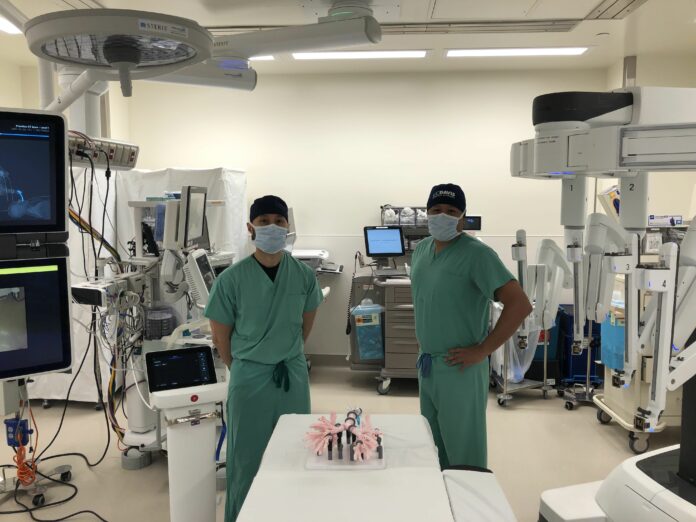Combining bronchoscopy and surgical platforms through robotic technology allows for quicker diagnosis and treatment for lung cancer patients
By BRANDON NGUYEN — science@theaggie.org
For the first time, physicians at UC Davis Health performed a robotically-assisted bronchoscopy, a procedure that examines lungs, for diagnosis and treatment of a lung cancer nodule within one operation.
Dr. Chinh Phan, an interventional pulmonologist at UC Davis Health, described the general procedure for a bronchoscopy.
“A bronchoscopy is basically a camera that you insert either through the nose or through a patient’s mouth that you can use as a diagnostic or therapeutic tool, depending on the abnormality,” Phan said. “So it essentially is a scope with a camera at the end. And recently in 2018 and 2019, the evolution of bronchoscopy has shifted towards robotic assistive technology.”
Conventionally, a patient would set up an appointment with a physician for a biopsy and bronchoscopy, which would take a few weeks before the results return. In addition, results might indicate the need for surgery, which must be booked weeks in advance. The robotically-assisted bronchoscopy procedure removes the extra waiting time and creates a one-stop shop for both diagnosis and surgical removal of any abnormalities, all in one visit.
A huge landmark lung cancer trial over a decade ago revealed that low dose CT scans enabled earlier diagnosis of lung cancers, leading to a 20% reduction in mortality and extended life from an average of 50 to 80 years old, according to Phan. To treat earlier stages of lung cancers, which often took on the form of smaller masses, new intricate technology was needed.
“Here’s the problem: because we pick up these lung cancers sooner, that means that these lesions are a lot smaller — we’re talking millimeters,” Phan said. “The older technology for diagnosing or to biopsy the lesion was difficult, using the traditional methods with the old sprocket scopes. Now this newer technology allows us to be more precise and get to these lesions safer and more efficiently.”
Aside from reducing patients’ anxiety during unnecessarily prolonged waiting times, this new approach has undoubtedly become the solution for enhanced precision and safety. Dr. Luis Godoy, a thoracic surgeon at UC Davis Health, underscored the significance of this procedure incorporating robotic assistance.
“The uniqueness of what Dr. Phan and I did was that we were able to combine both robotic approaches, the robotic bronchoscopy platform and the robotic surgery platform, in order to diagnose and stage the patient and then ultimately treat the patient, all within one single anesthetic event,” Godoy said.
The robotically-assisted bronchoscopy procedure uses a platform called the Ion Endoluminal Platform by Intuitive. The high-tech system creates a 3D map of the patient’s lungs using a CT scan. According to Godoy, the software then generates the safest and most efficient route through the lung to the nodule or mass. Once the most optimal route is determined, Phan would guide an ultrathin and ultra-maneuverable catheter to the site of the lung nodule or mass, where it is marked and biopsied with precision and stability. Lymph nodes are also biopsied during the same procedure and samples are evaluated on-site, all of which are completed within as little as 45 minutes.
If the lung nodule is determined to be an early-stage cancer, the surgical team led by Godoy uses the same navigational route to mark the area with dye to prepare for its removal. Then, the patient, still asleep, has a second robotic procedure using a platform called the Da Vinci Robotic System to remove the lung cancer mass on the same day.
“Dr. Phan was able to use the navigational robotic bronchoscopy to biopsy the lung nodule, confirm the cancer stage of the patient, and then I was able to do a lobectomy where I essentially remove the entire upper lobe of the right lung,” Godoy said. “We were able to do that all within a matter of hours and the patient went home the next day less than 24 hours later. I think that that’s one of the benefits of using the robotic system, which allows us to perform this complex operation minimally invasively and allows us to ultimately provide better care for the patients and get them home sooner with less pain than traditional open surgeries.”
Dr. Bahareh Nejad, the medical director of robotic surgery at UC Davis Health, echoed the sentiments of Godoy and Phan on how robotic assistance platforms have revolutionized interventional pulmonology.
“Innovations such as the robotic bronchoscopy platform are patient care at the absolute highest level, from diagnosis to treatment with a multidisciplinary team approach,” Nejad said. “We are excited to facilitate more growth with robotic surgery in our Robotics Program to make patient treatment better and more efficient.”
With the advent of successful robotic technologies, Godoy envisioned the continual rise in robotically-assisted procedures.
“I think in the future we’re going to be seeing a lot more of these procedures that are going to ultimately decrease that time from the moment that the patient gets diagnosed with a lung module to performing the diagnostic steps and ultimately the surgical treatment of their lung cancer in a shorter period of time,” Godoy said. “This patient I just saw in the clinic this past Wednesday was doing great; his recovery was phenomenal. He and his wife, who live six hours away, actually reported that they were so happy that they didn’t have to wait weeks, worrying and being anxious about their lung nodule and whether it was cancerous or not.”
Post-operatively, Godoy hoped to be able to extend and offer combined procedures such as the robotically-assisted bronchoscopy to patients who live remotely in order to expedite and enhance accessibility of treatment options.
Written by: Brandon Nguyen — science@theaggie.org




